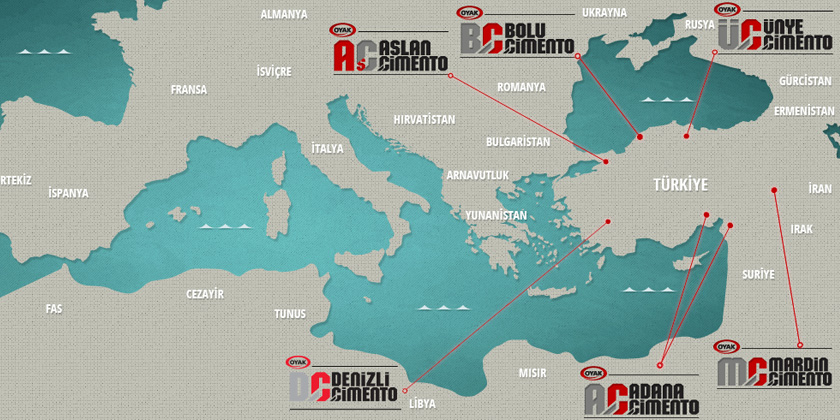Portland Cement
Cem l
- Portland cement is a hydraulic binder obtained by grinding portland cement clinker after adding a little amount of limestone as a setting regulating agent. It has a high strength gain and high strength as it contains a high amount of clinker. This product is for general use. It is a type of cement used in concrete manufacturing where high-strength concrete is required and the first strength is to be high.
Areas of Use
- In production of prefabricated building elements,
- In production of prestressed concrete,
- In structures such as highways, bridges, viaducts, etc.,
- In constructions performed with tunnel formwork system,
- In production of building chemicals,
- In production of briquettes and tiles,
- In foundation concrete applications.
|
Cem I 42,5 R |
General use |
Adana / Denizli / Bolu / Unye / Mardin / Aslan |
White Portland Cement
Cem l Beyaz
- White cement is a hydraulic binder produced for decorative purposes by grinding white clinker, which is obtained from a mixture of special-quality clay (pyrophyllite, kaolinite) and limestone, with gypsum. It is a type of cement used in binding of elements such as tiles, ceramics in luxurious architectural structures. It is one of the products with the highest strength and whiteness in the market. This product is for buildings that require high strength, for general use and structures with aesthetic purposes. Its basic distinctive properties are high strength gain, aesthetic and decorative features, smooth surface and elegant appearance. It has a minimum whiteness rate of 85%. It has a stable shade in addition to its high level of whiteness, which provides great advantage in production of building elements. It can be used in colored concrete and mortar. Thanks to its high level of whiteness and fine structure, it is used in production of building chemicals.
|
Cem I 52,5 R (White) |
Superior quality white cement: Minimum 85% whiteness ratio for general use and structures for aesthetic purposes |
Adana |
White Portland Limestone Cement
Cem l - ll
- It is a blended type of cement with minimum whiteness rate of 83%, obtained by adding various amounts of limestone into white clinker during the grinding process. It is for general use and structures with aesthetic purposes. The limestone in its composition enhances early strength of concrete and prevents surface cracks by reducing heat of hydration. With its fine quality, the product provides smoother surfaces. As blended cement, it is also an environment-friendly product.
Areas of Use
- Architectural and decorative concrete manufacturing works
- Adhesive bonding and grouting material manufacturing works
- Premixed plaster and mortar manufacturing works
- Work-of-art designs
- Park and garden furniture designs
- Floor covering works
- Historical artifact renovation
|
Cem II White |
Blended white cement: Minimum 82% whiteness ratio for general use and structures for aesthetic purposes |
Adana |
Portland Composite Cement
Cem ll
- This product is a type of blended cement obtained by grinding portland cement clinker with a little amount of limestone as a mineral additive and a setting regulating agent. It can be used in areas where portland cement is used. As it contains additives, its heat of hydration is lower in comparison with portland cement. Type CEM II/B-M (S-P) 42,5R product is included in the cement class with high early strength. Its composition contains granulated blast furnace slag and pozzolana. Similarly, the composition of type CEM II/B-M (S-P-Q) 42,5N product contains two different types of pozzolana and granulated blast furnace slag. While pozzolana increases early strength, granulated blast furnace slag enhances strength at later ages. It also increases resistance of concrete against external impacts in aggressive environments containing chemicals such as sulfate, chloride, etc.
Areas of Use
- In applications for general purposes,
- In production of briquettes and tiles,
- In production of prefabricated building elements,
- In mass concrete and plaster.

|
Cem II |
Generally used in areas where blended cement is used and higher strength is required, in construction of pipe culverts, special project concrete and in production of building chemicals. |
Adana / Denizli / Bolu / Unye / Mardin / Aslan |
Blast Furnace Slag Cement
Cem lII
- Granuleted blast furnace slag produced by metallurgy plants in waste material class can be used as an additive in cement production as it has hydraulic binding feature. Iskenderun Cement Grinding Plant, launched to process the granulated blast furnace slag which is a product of Iskenderun Iron & Steel Plant in cement production, was acquired by Adana Cement in 2007, taking a part in blast furnace cement industry.
- Blast furnace cement, which performs high strength against chemical attacks thanks to its structure, has a low heat of hydration and is known to be more resistant than CEM I Portland cement in the long term, can be used in dams, harbours, treatment plants, irrigation canals, bridges and many other projects and is preferred more and more thanks to its economic quality. Moreover, this product which requires less use of clinker is a type of cement which has minimum impact on the environment in today's conditions.
- With Iskenderun II plant which was commissioned within Isdemir site, blast furnace cement production capacity of Adana Cement is currently 2 million ton per year.

|
Cem III |
Blast Furnace Slag Cement: In coast and harbor constructions, offshore structures, waste water plants, foundation piles, canalettes, dams, concrete or reinforced concrete underground water pipes, industrial grounds under sulphate effect, treatment plants, tunnel linings, in constructions for general purpose and in mass concrete requiring low heat of hydration. |
Adana / Bolu / Unye |
Pozzolanic Cement
- Workability and high hydraulic performance,
- Reaction characteristics with mineral additives such as ash, slag, etc.,
- High performance displayed in construction meterials production.
|
Cem IV |
It is generally used in dams, plaster and masonry mortar, flumes, treatment plants, mass concrete casting, paving concrete and production of building chemicals. |
Bolu / Denizli / Unye / Mardin |
Sulphate Resisting Pozzolanic Cement
- It is generally used in dams, plaster and masonry mortar, flumes, treatment plants, mass concrete casting, paving concrete and production of building chemicals.
|
Cem IV-SR |
It is generally used in dams, plaster and masonry mortar, flumes, treatment plants, mass concrete casting, paving concrete and production of building chemicals. |
Bolu |
Composite Cement
- This product is a type of blended cement obtained by grinding portland cement clinker with a little amount of limestone as a mineral additive and a setting regulating agent. Portland contains more additives in comparison with composite cement. The composition of type CEM V/A (S-P) 32,5 R product contains pozzolana and granulated blast furnace slag. Similarly, the composition of type CEM V/A (S-P-Q) 32,5 R product contains two different types of pozzolana and granulated blast furnace slag. While pozzolana increases early strength, granulated blast furnace slag enhances strength at later ages. Composite cement increases resistance of concrete against external impacts in attacks of chemicals such as sulfate, chloride, etc.
Kullanım Alanları
- Dam constructions,
- Plaster and masonry mortar,
- Flumes, treatment plants,
- In mass concrete casting,
- Production of paving concrete and building chemicals.
|
Cem V |
It is generally used in dams, plaster and masonry mortar, flumes, treatment plants, mass concrete casting, paving concrete and production of building chemicals. |
Adana / Aslan |
Sulphate Resisting Portland Cement
Applications
- In concretes exposed to chemical attacks,
- Areas exposed to sea water and underground water,
- Soil bases that contain sulphates.
Sülfata Dayanıklı Portland Çimento
|
Cem I - SR |
It is used in constructions on areas which are under effect of sulphate zones and seawater as well as in construction of foundations for underwater structures, bridges, dams and harbors and retaining walls. |
Mardin / Denizli / Bolu |
Special Types of Cement
- Various types of cement designed specially depending on customer needs: The cement used in Marmaray underwater tube tunnel, sulfate-resistant cement, petroleum cement, etc.
|
|
Various types of cement designed specially depending on customer needs: The cement used in Marmaray underwater tube tunnel, Izmit Bay Suspension Bridge, petroleum cement, etc. |
Adana / Bolu / Unye / Mardin |
Apı Well Cement
- API Well Cement, which can be used under severe conditions like 260 degrees celsius and 20.000 psi, shows excellent workability and mechanical properties on drilling applications. This is a special type of cement which does not hardens to a depth of 6.000 meter and it has appropriate strength properties for drilling procedures under high temperature and high pressure.
|
G-Sınıfı; HSR-Tipi
|
API Well Cement, which can be used under severe conditions like 260 degrees celsius and 20.000 psi, shows excellent workability and mechanical properties on drilling applications. This is a special type of cement which does not hardens to a depth of 6.000 meter and it has appropriate strength properties for drilling procedures under high temperature and high pressure. |
Class G; Type HSR |
Fly Ash
- Fly ash is obtained by electrostatically or mechanically precipitating the dust granules, available in the flue gas discharged from the ovens, where pulverized coal is burned.
|
|
Fly ash is obtained by electrostatically or mechanically precipitating the dust granules, available in the flue gas discharged from the ovens, where pulverized coal is burned. |
Ünye |
| Kraft Paper |
|
Kraft Bag Paper (70 to 100 g/m²), Packaging Paper (70 g/m²) , Klupak Paper (70 to 90 g/m²), Klupak S Paper (80 to 90 g/m²), Kraftliner (125 to 150 g/m²) |
OYKA Paper Packing |
| Paper Bag |
|
Kraft paper bags of 2-4 plies and 4-8 colors. Bags with polyethylene in middle layers and an outer surface in white color. Bags for cement, lime, gypsum, chemical products, building products and food. |
OYKA Paper Packing |













